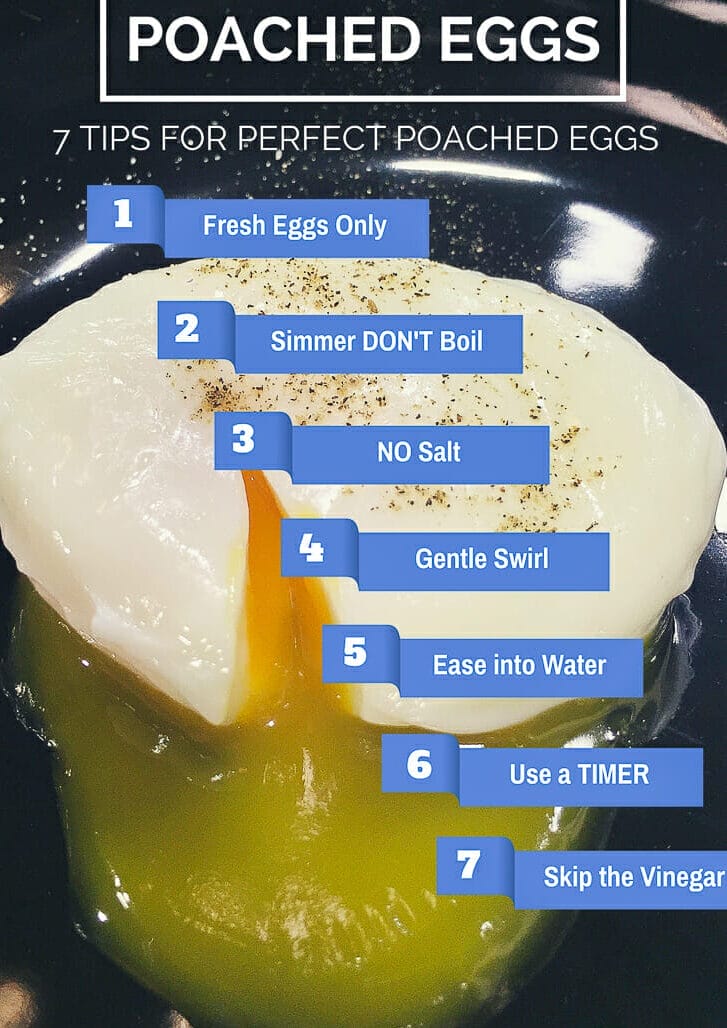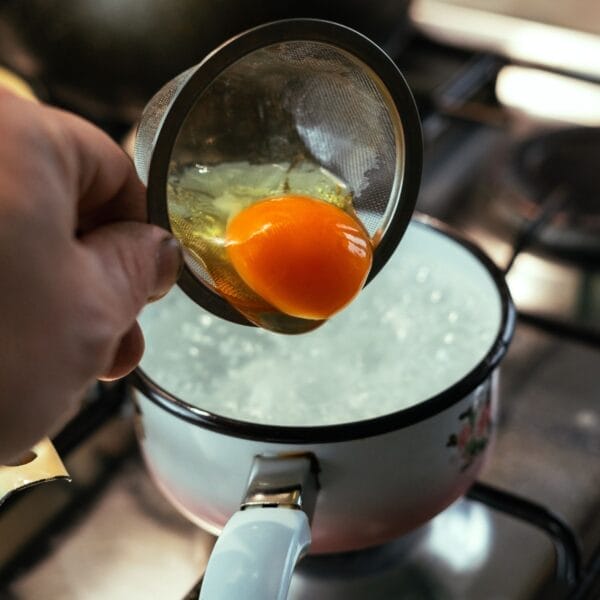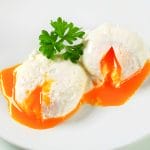7 Tips for Perfect Poached Eggs
Poaching an egg can be a little intimidating, so I am happy to share these 7 tips for making beautiful poached eggs. A perfect poached egg has a cooked but tender egg white with a soft yolk. It is oval or tear drop shaped with few drifting egg white strands.

The classic way to poach an egg is to submerse it in lightly simmering water. That’s actually, what poaching means – to cook something by immersing it in liquid that is just shy of boiling (if you want to be specific, it’s at about 160–185 °F (71–85 °C)).

Dropping a raw egg into hot water sounds tricky, but by following these seven tips, you’ll be well on your way to poaching success and a delicious breakfast, lunch or dinner. We had poached eggs on toasted English muffins with back bacon, garlic fried spinach and a cheesy muffin top.

7 Tips for Perfect Poached Eggs

And here’s a more detailed description of each.
1. Use Fresh Eggs Only
If you start with the freshest eggs you can get, making great poached eggs is almost foolproof. When you’re at the grocery store reach for the eggs at the back of the cooler to get the newest stock! The older the eggs, the more unruly your egg whites will be making it difficult to get a nice shape with tucked in whites. If all you have are older eggs, consider using a silicone egg poacher or an egg poaching pan to help keep the shape of your poached egg.
Note: While fresh eggs are best for poaching, older eggs are better for hard cooking. Check out How to Make Easy to Peel Hard Cooked Eggs.
2. Simmer, Don’t Boil
The temperature of your water is important for keeping your egg whites tender. A full boil will lead to tough, rubbery egg whites. I like to bring the water to a boil and then turn it down low so there are barely any bubbles visible. If you want to be technical, the ideal temp is 160–185 °F (71–85 °C) – but really all you need to do is watch the bubbles.
And while we’re on the topic of the water. Make sure you have plenty of water in the pot – about 3 inches so that the egg is completely immersed and then some.
3. NO Salt
Don’t add salt to the poaching water. Salt actually breaks up the egg whites and makes them want to go their own way – the exact opposite of what you want.
4. Create a Gentle Swirl
Give the egg white a push in the right direction by stirring the almost boiling water into a mini whirlpool. You don’t need a major whirlpool, just a gentle swirl that will help the egg white tuck around the yolk.
5. Ease the Egg into the Water
You’re not dropping a bomb – be gentle. Break the egg into a custard cup, lower it into the water and let the egg slide gently into the swirl.

6. Use a Timer
If you’re anything like me, you’ll quickly lose track of time as your egg is poaching away. Set a timer to get the perfect consistency. Aim for three minutes for a tender, cooked egg white and a yolk that is starting to form an edge but is still soft and runny. Adjust from there for personal preferences but remember, the longer you poach your egg the tougher your egg white will get.
7. Skip the Vinegar
If you’re doing everything else on this list and you have fresh eggs, you do not need to add vinegar to the water. It’s true, vinegar does help coagulate the egg white, however, it does leave a lingering flavor and smell. It also has the tendency to make the egg white a little tougher and sometimes even a little grainy, with little bumps on the surface.
Here’s a recipe that puts all of these tips into practice.
Recipe: Poached Eggs
Making a Poached Egg
Ingredients
- 1 fresh egg
- water
Instructions
- Fill a medium sized pot with 3 inches of water.
- Bring water to a boil.
- Once you see the boil, reduce the heat until there are a few tiny bubbles – no rolling boil.
- Meanwhile, break an egg into a small custard cup or dish.
- Once the water is at the right temperature, use a wooden spoon to spin the water into a gentle swirl.
- Lower the cup with the egg to the water so that the lip of the cup is in the water and the egg can slide gently into the water.
- Start your timer for 3 minutes as soon as your egg is in the water.
- The egg will settle to the bottom with the egg white swirling all about. At this point, you may think things won’t work out, but give it time. Soon enough the egg white will tuck itself next to the egg yolk.
- If it looks like the egg is sticking to the bottom of the pot, you can gently lift it off the bottom with your slotted spoon.
- Once the 3 minutes are up, use a slotted spoon to lift the egg out of the water.
- Place on a paper towel and pat dry.
- Move to a serving plate or on top of toast, asparagus, lettuce, spinach or whatever.
- Enjoy!
Notes
Nutrition Facts (per serving)
More eggscellent egg posts
- How to Make Perfectly Peeled Hard Boiled Eggs (this post has a little YouTube video!)
- Top 10 Frequently Asked Egg Questions
- How to Choose the Right Eggs: Standard, Free Run, Free Range, Organic, Omega3, Pastured
- Hard Cooked Eggs in the Oven: Not All their Cracked Up to Be
- How to Freeze Eggs
- 8 Tips for the Best Deviled Eggs
Select, store and serve seasonal food for everyday cooking with Getty. Getty is a food educator and Professional Home Economist, who loves sharing tips and recipes following the seasons from her Canadian kitchen. Sign up to get seasonal tips and recipes delivered to your inbox. Learn more about Getty or check out her books and pdf guides.


